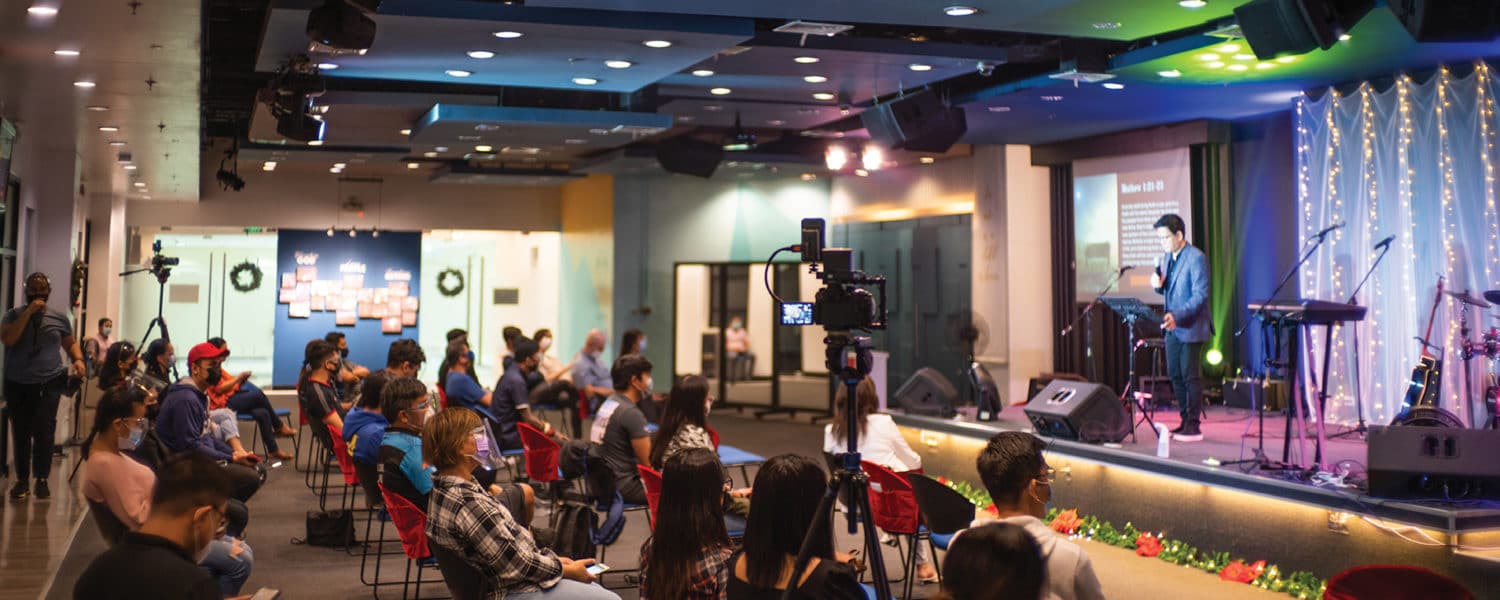By Belinda King
Most people are familiar with hybrids: cars, for example. Hybrid cars run on two different kinds of fuel — electricity and gasoline. But as we slowly rebound from the COVID-19 pandemic, another kind of hybrid emerged: hybrid worship.
Many congregations that scrambled to improve their digital presence during COVID have been returning to in-person worship. Most value the lessons and opportunities gained in the forced immersion of online worship services.
After all, with this new outlet, congregations are no longer limited to their physical footprint. They can reach not only worshipers in lockdown or otherwise homebound, but also worshipers as far as the Internet can reach.
With any innovation, managing the change — taking advantage of the opportunities it offers — requires intention, new technical skills and a little luck.
Here are a few tips to help make the most of this brave new world of hybrid worship:
The one shall become two.
With two audiences (one in the pew and one on the other side of a video screen), worship preparation can be tricky. Lighting and audio needs are different in each medium.
Finding the sweet spot for things like camera placement, lights, microphones that give the video audience access without being a distraction to in-person worshipers takes trial and error. It also takes the right equipment.
* Work with volunteers and vendors with expertise in equipment needed to find the sweet spot for things like camera placement, lights and microphones. You want to give your video audience access without being a distraction to in-person worshipers.
* Test changes during the week before assuming they will work when the service goes live.
* Remember that the pastor is not the tech support. While many clergy have some basic A/V skills, this is not the best use of time for the pastor, any more than changing lightbulbs or fixing the church van.
Enlist the help of both audiences in making improvements.
* Remind worshipers in each context of the presence of the other (welcome both audiences, explain what is happening live if the video audience isn’t in on the in-person view).
* Ask for constructive input from parishioners. What’s working? What could use improvement?
* Communicate with both audiences about the challenges of getting the sound or lights or other technical pieces to work seamlessly.
* Thank all parties for finding the patience it takes to navigate this new format.
Consider age-appropriate audience needs that can impact programming.
* Small groups may flourish with new easy-access options for gathering. Talk with leaders of each age or interest group for ways to customize the technology.
* Would the youth benefit from a virtual game night that allows them access without driving?
* Might the men’s group have a special guest speaker who wouldn’t otherwise be available or affordable with travel costs factored in?
* Invite the youth to lead virtual worship and learn from them some new ideas to incorporate in your service of worship more frequently.
Be creative about “community” time for viewers.
Let’s face it: Communion is all about the BODY of believers. Translating this beloved ceremony to a digital context is daunting. Fellowship and passing the peace are also difficult to manage virtually. But there are many ways to make those virtual times feel more personal and sacred.
* Consider a camera in the fellowship hall, where on-site worshipers can see a screen of virtual visitors and live chat for a time with them. (Having an elder or deacon host this camera can keep traffic moving to it. Having the pastor make an appearance early on is also advisable.)
* During passing the peace, invite virtual visitors to share in the chat their greetings for one another. (Make sure a host is present in the chat to be intentional with responses. This may be a place to receive prayer requests, as well. Staffing for this role may be more pastor than tech support.)
* Communion can be as complex as “worship in a box” where elements are prepared ahead for pick up or delivery, as Light of the World CC in Indianapolis practiced during the lockdown; or as simple as inviting video participants to find crackers and a beverage of some kind for the communion time so they can participate from home.
* On-screen you may show in-person worshipers receiving communion, or perhaps share still images that evoke a sense of community and connection.
* One tip to remember: Even after months of worship, you will still have new viewers. If you operate like everyone already knows the ropes, you will be unintentionally excluding newcomers. So, all those “instructions” that are necessary to help people worship with intention should be included at least as text on screen if not spoken during the live service.
Platforms vary in terms of the best application for each.
Do some research on platforms to learn what types work best for your virtual experiences.
* Livestream TV, Facebook, YouTube, FreeOnlineChurch.com and Vimeo are all online platforms that pair well with worship. There are advantages (and disadvantages) to each. Many churches have already tried one or more of these platforms. Experimenting with alternatives can uncover new opportunities. Talk with other faith communities for secrets to their success on a particular platform (or by utilizing more than one at a time).
* Some options for connection platforms where participants can be more than just observers include: Marco Polo – a group video messaging app, Facebook Messenger, You Version Bible app, Zoom, Flipgrid for youth ministry and FreeConferenceCall.com. Even simple free game apps, like HouseParty, which features closing the “room” after invited parties have arrived, can offer a little downtime and conversation.
Of course, safety is of utmost importance.
With our awareness of how easily viruses can spread, we may be more aware than ever that viruses and other safety issues also plague our virtual spaces. Ask these questions:
* How can we best prepare our sacred spaces for low-risk, in-person worship vis-à-vis continued virus spread?
* What cybersecurity do we need in place for our digital worshiping environment and its users?
Keep in mind the ecumenical community.
As a whole community of learners in any town or city, we are learning together. Reach out to your neighboring congregations, both to share what you are learning and to learn what they have already found helpful for thriving in this hybrid worship context.
Belinda King is vice president of Disciples Church Extension Fund (DCEF), which was founded in 1883 to help Disciples congregations and mission stations secure land and construct new buildings, www.disciplescef.org.










